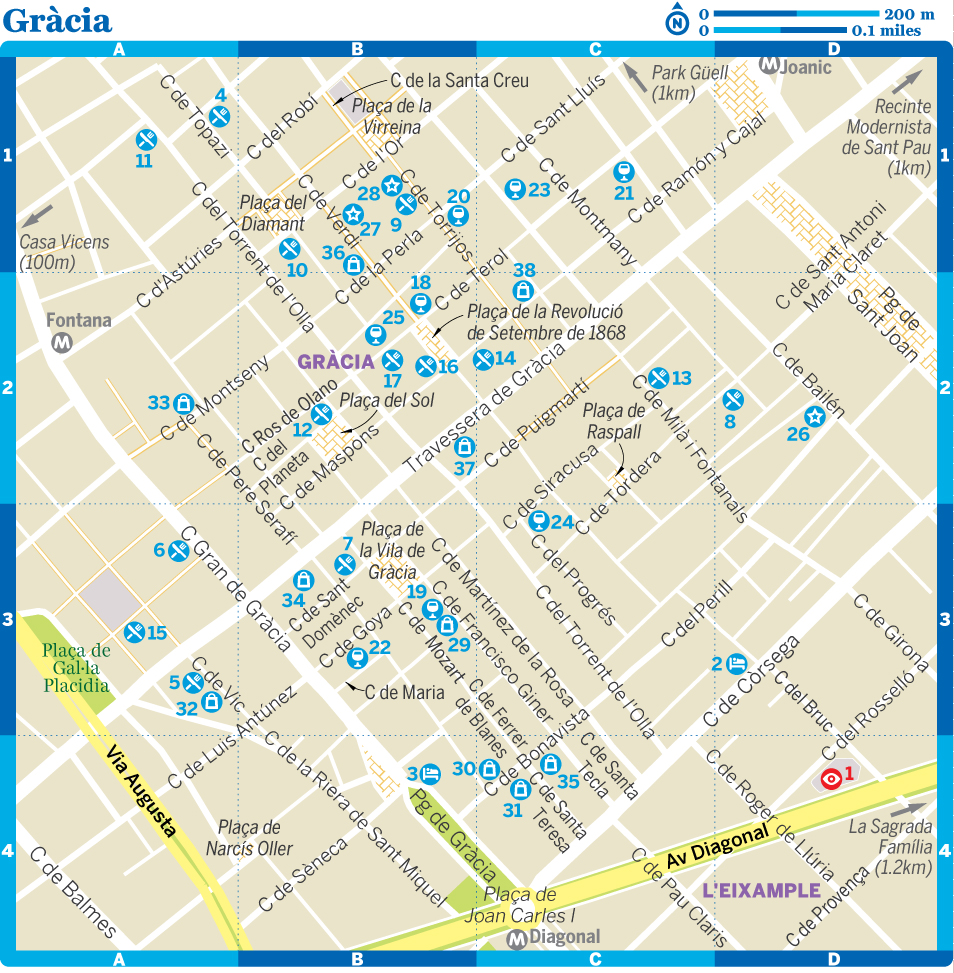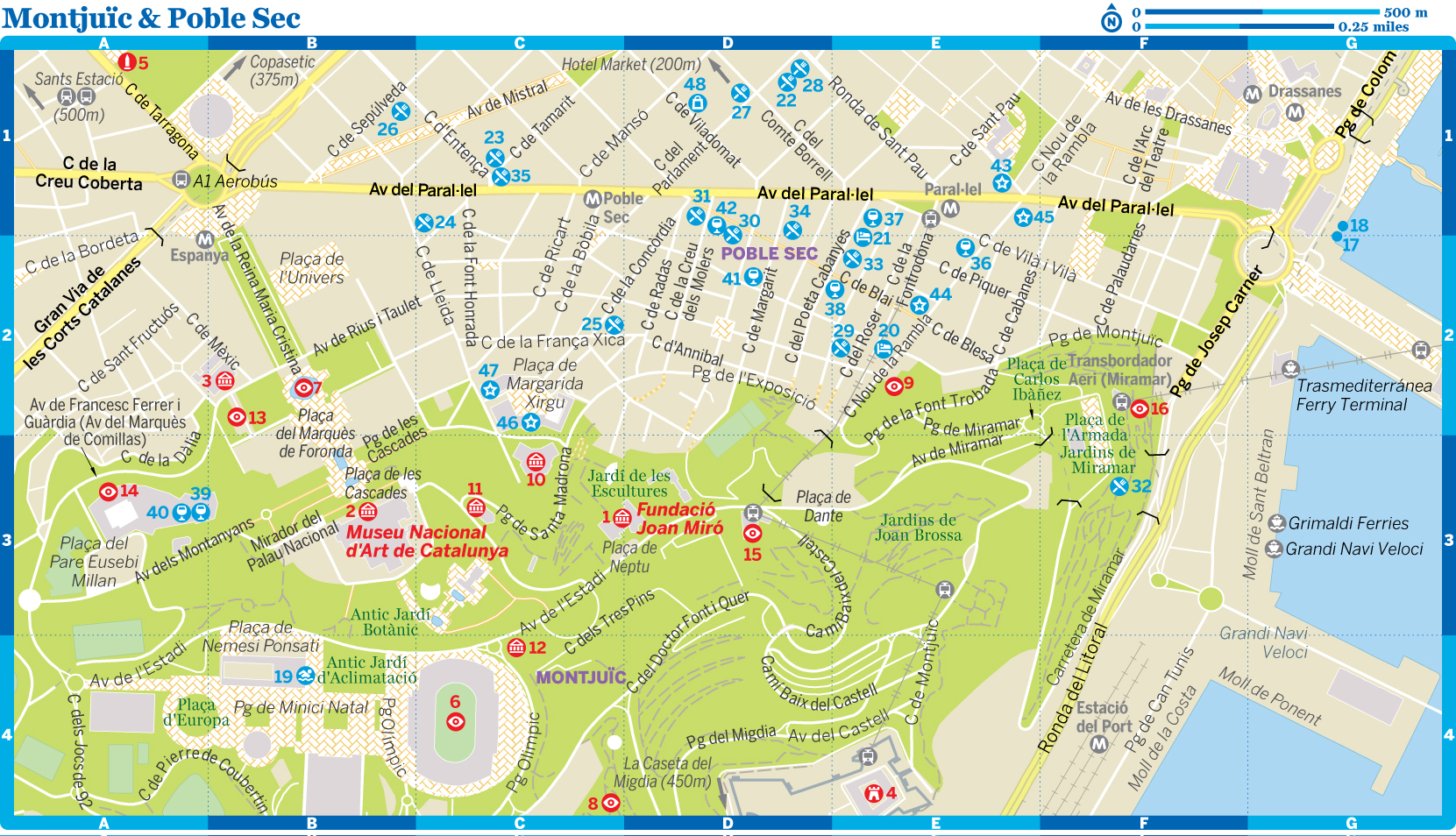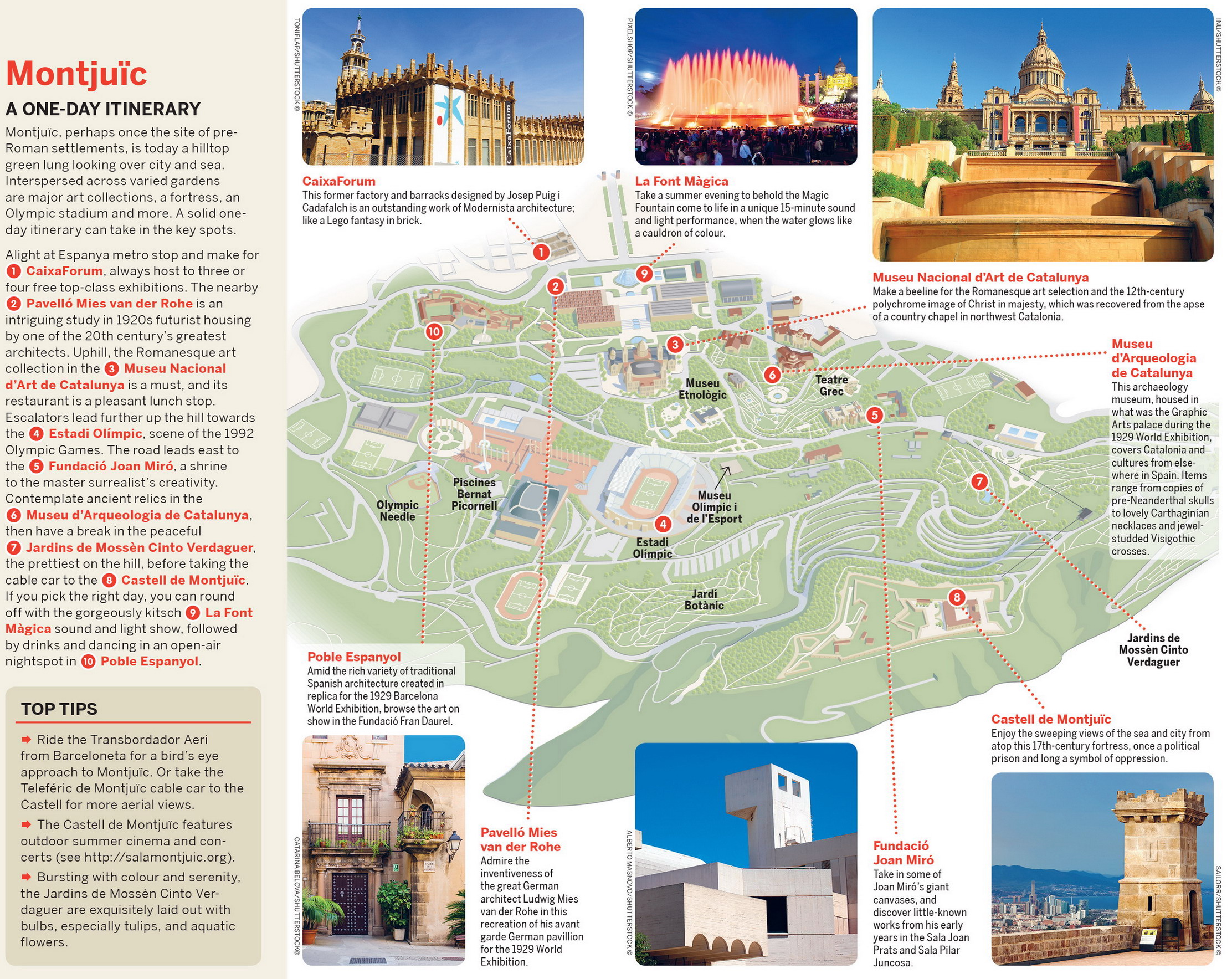![]() oCasa Batlló ARCHITECTURE
oCasa Batlló ARCHITECTURE
(MAP GOOGLE MAP; ![]() %93 216 03 06; www.casabatllo.es; Passeig de Gràcia 43; adult/child €28/free;
%93 216 03 06; www.casabatllo.es; Passeig de Gràcia 43; adult/child €28/free; ![]() h9am-9pm, last admission 8pm;
h9am-9pm, last admission 8pm; ![]() mPasseig de Gràcia)
mPasseig de Gràcia)
One of the strangest residential buildings in Europe, this is Gaudí at his hallucinatory best. The facade, sprinkled with bits of blue, mauve and green tiles and studded with wave-shaped window frames and balconies, rises to an uneven blue-tiled roof with a solitary tower.
It is one of the three houses on the block between Carrer del Consell de Cent and Carrer d’Aragó that gave it the playful name Illa de la Discòrdia (Spanish: Manzana de la Discordia), meaning ‘Apple (Block) of Discord’. The others are Puig i Cadafalch’s Casa Amatller and Domènech i Montaner’s Casa Lleó Morera. They were all renovated between 1898 and 1906 and show how eclectic a ‘style’ Modernisme was.
Locals know Casa Batlló variously as the casa dels ossos (house of bones) or casa del drac (house of the dragon). It’s easy enough to see why. The balconies look like the bony jaws of some strange beast and the roof represents Sant Jordi (St George) and the dragon. Even the roof was built to look like the shape of an animal’s back, with shiny scales – the ‘spine’ changes colour as you walk around. If you stare long enough at the building, it seems almost to be a living being. Before going inside, take a look at the pavement. Each paving piece carries stylised images of an octopus and a starfish, designs that Gaudí originally cooked up for Casa Batlló.
When Gaudí was commissioned to refashion this building, he went to town inside and out. The internal light wells shimmer with tiles of deep-sea blue. Gaudí eschewed the straight line, and so the staircase wafts you up to the 1st (main) floor, where the salon looks on to Passeig de Gràcia. Everything swirls: the ceiling is twisted into a vortex around its sunlike lamp; the doors, window and skylights are dreamy waves of wood and coloured glass. The same themes continue in the other rooms and covered terrace. The attic is characterised by Gaudí trademark hyperboloid arches. Twisting, tiled chimney pots add a surreal touch to the roof.
![]() oLa Pedrera ARCHITECTURE
oLa Pedrera ARCHITECTURE
(MAP GOOGLE MAP; Casa Milà; ![]() %902 202138; www.lapedrera.com; Passeig de Gràcia 92; adult/child €25/15;
%902 202138; www.lapedrera.com; Passeig de Gràcia 92; adult/child €25/15; ![]() h9am-8.30pm Mar-Oct, 9am-6.30pm Nov-Feb;
h9am-8.30pm Mar-Oct, 9am-6.30pm Nov-Feb; ![]() mDiagonal)
mDiagonal)
This madcap Gaudí masterpiece was built in 1905–10 as a combined apartment and office block. Formally called Casa Milà, after the businessman who commissioned it, it is better known as La Pedrera (the Quarry) because of its uneven grey stone facade, which ripples around the corner of Carrer de Provença.
Recinte Modernista de Sant Pau ARCHITECTURE
(![]() %93 553 78 01; www.santpaubarcelona.org; Carrer de Sant Antoni Maria Claret 167; adult/child €13/free;
%93 553 78 01; www.santpaubarcelona.org; Carrer de Sant Antoni Maria Claret 167; adult/child €13/free; ![]() h9.30am-6.30pm Mon-Sat, to 2.30pm Sun Apr-Oct, 9.30am-4.30pm Mon-Sat, to 2.30pm Sun Nov-Mar;
h9.30am-6.30pm Mon-Sat, to 2.30pm Sun Apr-Oct, 9.30am-4.30pm Mon-Sat, to 2.30pm Sun Nov-Mar; ![]() mSant Pau/Dos de Maig)
mSant Pau/Dos de Maig)
Domènech i Montaner outdid himself as architect and philanthropist with the Modernista Hospital de la Santa Creu i de Sant Pau, renamed the ‘Recinte Modernista’ in 2014. It was long considered one of the city’s most important hospitals but was repurposed, its various spaces becoming cultural centres, offices and something of a monument. The complex, including 16 pavilions – together with the Palau de la Música Catalana, a joint Unesco World Heritage Site – is lavishly decorated and each pavilion is unique.
Casa Amatller ARCHITECTURE
(MAP GOOGLE MAP; ![]() %93 461 74 60; www.amatller.org; Passeig de Gràcia 41; adult/child 1hr guided tour €17/8.50, 40min multimedia tour €14/7, with 20min chocolate tasting €17/10;
%93 461 74 60; www.amatller.org; Passeig de Gràcia 41; adult/child 1hr guided tour €17/8.50, 40min multimedia tour €14/7, with 20min chocolate tasting €17/10; ![]() h11am-6pm;
h11am-6pm; ![]() mPasseig de Gràcia)
mPasseig de Gràcia)
One of Puig i Cadafalch’s most striking flights of Modernista fantasy, Casa Amatller combines Gothic window frames with a stepped gable borrowed from Dutch urban architecture. But the busts and reliefs of dragons, knights and other characters dripping off the main facade are pure caprice.
The pillared foyer and staircase lit by stained glass are like the inside of some romantic castle. The building was renovated in 1900 for the chocolate baron and philanthropist Antoni Amatller (1851–1910).
Fundació Antoni Tàpies GALLERY
(MAP GOOGLE MAP; ![]() %93 487 03 15; www.fundaciotapies.org; Carrer d’Aragó 255; adult/child €7/5.60;
%93 487 03 15; www.fundaciotapies.org; Carrer d’Aragó 255; adult/child €7/5.60; ![]() h10am-7pm Tue-Sun;
h10am-7pm Tue-Sun; ![]() mPasseig de Gràcia)
mPasseig de Gràcia)
The Fundació Antoni Tàpies is both a pioneering Modernista building (completed in 1885) and the major collection of leading 20th-century Catalan artist Antoni Tàpies. Tàpies died in February 2012, aged 88; known for his esoteric work, he left behind a powerful range of paintings and a foundation intended to promote contemporary artists. Admission includes an audioguide.
Museu Egipci MUSEUM
(MAP GOOGLE MAP; ![]() %93 488 01 88; www.museuegipci.com; Carrer de València 284; adult/child €11/5;
%93 488 01 88; www.museuegipci.com; Carrer de València 284; adult/child €11/5; ![]() h10am-8pm Mon-Sat, to 2pm Sun mid-Jun–early Oct & Dec, 10am-2pm & 4-8pm Mon-Fri, 10am-8pm Sat, 10am-2pm Sun Jan–mid-Jun & early Oct-Nov;
h10am-8pm Mon-Sat, to 2pm Sun mid-Jun–early Oct & Dec, 10am-2pm & 4-8pm Mon-Fri, 10am-8pm Sat, 10am-2pm Sun Jan–mid-Jun & early Oct-Nov; ![]() mPasseig de Gràcia)
mPasseig de Gràcia)
Hotel magnate Jordi Clos has spent much of his life collecting ancient Egyptian artefacts, brought together in this private museum. It’s divided into different thematic areas (the pharaoh, religion, funerary practices, mummification, crafts etc) and boasts an interesting variety of exhibits.
Sala Fundación MAPFRE GALLERY
(MAP GOOGLE MAP; ![]() %93 401 26 03; www.fundacionmapfre.org; Carrer de la Diputació 250; adult/child €3/free, Mon free;
%93 401 26 03; www.fundacionmapfre.org; Carrer de la Diputació 250; adult/child €3/free, Mon free; ![]() h2-8pm Mon, 10am-8pm Tue-Sat, 11am-7pm Sun;
h2-8pm Mon, 10am-8pm Tue-Sat, 11am-7pm Sun; ![]() mPasseig de Gràcia)
mPasseig de Gràcia)
Formerly the Fundación Francisco Godia, this stunning, carefully restored Modernista residence was taken over in 2015 by the charitable cultural arm of Spanish insurance giants MAPFRE as a space for art and photography exhibitions. Housed in the Casa Garriga i Nogués, it is a stunning, carefully restored Modernista residence originally built for a rich banking family by Enric Sagnier in 1902–05.
Casa de les Punxes ARCHITECTURE
(MAP GOOGLE MAP; Casa Terrades; ![]() %93 016 01 28; www.casadelespunxes.com; Avinguda Diagonal 420; adult/child audiogude tour €12.50/11.25, guided tour €20/17;
%93 016 01 28; www.casadelespunxes.com; Avinguda Diagonal 420; adult/child audiogude tour €12.50/11.25, guided tour €20/17; ![]() h9am-8pm;
h9am-8pm; ![]() mDiagonal)
mDiagonal)
Puig i Cadafalch’s Casa Terrades, completed in 1905, is better known as the Casa de les Punxes (House of Spikes) because of its pointed turrets. Resembling a medieval castle, the former apartment block is the only fully detached building in L’Eixample, and was declared a national monument in 1976. Since 2017 it has been open to the public. Visits take in its stained-glass bay windows, handsome iron staircase, and rooftop. Guided tours in English lasting one hour depart at 4pm.
Museu del Modernisme Barcelona MUSEUM
(MAP GOOGLE MAP; ![]() %93 272 28 96; www.mmbcn.cat; Carrer de Balmes 48; adult/child €10/5;
%93 272 28 96; www.mmbcn.cat; Carrer de Balmes 48; adult/child €10/5; ![]() h10.30am-7pm Tue-Sat, to 2pm Sun;
h10.30am-7pm Tue-Sat, to 2pm Sun; ![]() mPasseig de Gràcia)
mPasseig de Gràcia)
Housed in a Modernista building, this museum’s ground floor seems like a big Modernista furniture showroom. Several items by Antoni Gaudí, including chairs from Casa Batlló and a mirror from Casa Calvet, are supplemented by a host of items by his lesser-known contemporaries, including some typically whimsical, mock medieval pieces by Puig i Cadafalch.
Casa Lleó Morera ARCHITECTURE
(MAP GOOGLE MAP; Passeig de Gràcia 35; ![]() mPasseig de Gràcia)
mPasseig de Gràcia)
Domènech i Montaner’s 1905 contribution to the Illa de la Discòrdia, with Modernista carving outside and a bright, tiled lobby in which floral motifs predominate, is perhaps the least odd-looking of the three main buildings on the block. Luxury fashion store Loewe (MAP GOOGLE MAP; ![]() %93 216 04 00; www.loewe.com; Passeig de Gràcia 35;
%93 216 04 00; www.loewe.com; Passeig de Gràcia 35; ![]() h10am-8.30pm Mon-Sat;
h10am-8.30pm Mon-Sat; ![]() mPasseig de Gràcia) is located here.
mPasseig de Gràcia) is located here.
Palau Robert GALLERY
(MAP GOOGLE MAP; ![]() %93 238 80 91; http://palaurobert.gencat.cat; Passeig de Gràcia 107;
%93 238 80 91; http://palaurobert.gencat.cat; Passeig de Gràcia 107; ![]() h9am-8pm Mon-Sat, to 2.30pm Sun;
h9am-8pm Mon-Sat, to 2.30pm Sun; ![]() mDiagonal)
mDiagonal) ![]() F
F
Catalonia’s regional tourist office also serves as an exhibition space, mostly for shows with Catalan themes. In summer, concerts are occasionally held in the peaceful gardens at the back of the 1903-completed building, or in its main hall.
Fundació Suñol GALLERY
(MAP GOOGLE MAP; ![]() %93 496 10 32; www.fundaciosunol.org; Passeig de Gràcia 98; adult/child €4/free;
%93 496 10 32; www.fundaciosunol.org; Passeig de Gràcia 98; adult/child €4/free; ![]() h11am-2pm & 4-8pm Mon-Fri, 4-8pm Sat;
h11am-2pm & 4-8pm Mon-Fri, 4-8pm Sat; ![]() mDiagonal)
mDiagonal)
Rotating exhibitions of portions of this private collection of mostly 20th-century art (some 1200 works in total) offer anything from Man Ray’s photography to sculptures by Alberto Giacometti. Over two floors, you are most likely to run into Spanish artists – anyone from Picasso to Jaume Plensa – along with a sprinkling of international artists.
Museu del Perfum MUSEUM
(MAP GOOGLE MAP; ![]() %93 216 01 21; www.museudelperfum.com; Passeig de Gràcia 39; adult/child €5/free;
%93 216 01 21; www.museudelperfum.com; Passeig de Gràcia 39; adult/child €5/free; ![]() h10.30am-8pm Mon-Fri, 11am-2pm Sat;
h10.30am-8pm Mon-Fri, 11am-2pm Sat; ![]() mPasseig de Gràcia)
mPasseig de Gràcia)
At the back of the Regia perfume store (MAP; ![]() %93 216 01 21; www.regia.es; Passeig de Gràcia 39;
%93 216 01 21; www.regia.es; Passeig de Gràcia 39; ![]() h9.30am-8.30pm Mon-Fri, 10.30am-8.30pm Sat;
h9.30am-8.30pm Mon-Fri, 10.30am-8.30pm Sat; ![]() mPasseig de Gràcia), this museum contains oddities from ancient Egyptian and Roman scent receptacles (the latter mostly from the 1st to 3rd centuries AD) to classic eau de cologne bottles – all in all, some 5000 bottles of infinite shapes, sizes and histories. Other items include ancient bronze Etruscan tweezers and little early-19th-century potpourri bowls made of fine Sèvres porcelain. Also on show are old catalogues and advertising posters.
mPasseig de Gràcia), this museum contains oddities from ancient Egyptian and Roman scent receptacles (the latter mostly from the 1st to 3rd centuries AD) to classic eau de cologne bottles – all in all, some 5000 bottles of infinite shapes, sizes and histories. Other items include ancient bronze Etruscan tweezers and little early-19th-century potpourri bowls made of fine Sèvres porcelain. Also on show are old catalogues and advertising posters.
Platja de l’Eixample BEACH
(MAP GOOGLE MAP; ![]() %93 423 43 50; Carrer de Roger de Llúria 56; €1.55;
%93 423 43 50; Carrer de Roger de Llúria 56; €1.55; ![]() h10am-8pm late Jun–Sep;
h10am-8pm late Jun–Sep; ![]() mGirona)
mGirona)
In a hidden garden inside a typical Eixample block is an old water tower and an urban ‘beach’, the Platja de l’Eixample. In reality, this is a knee-height swimming pool (60cm at its deepest) surrounded by sand. It’s perfect for little ones, with lifeguards on hand.
Plaça de Catalunya SQUARE
(MAP GOOGLE MAP; ![]() mCatalunya)
mCatalunya)
At the intersection of the old city and L’Eixample, Plaça de Catalunya is the city’s central transport hub, both for buses and trains, and a convenient meeting point. A large square with some impressive fountains and elegant statuary, it is ringed with four lanes of traffic and thus is not really a place to linger.
BEST BEACHES
Barcelona has miles of golden shoreline. Some of its best beaches are:
Platja de la Barceloneta (MAP GOOGLE MAP; http://lameva.barcelona.cat; ![]() mBarceloneta) Just east of its namesake neighbourhood, Barceloneta’s golden-sand beach is beloved by sunseekers, and has ample eating and drinking options just inland when you need a bit of refreshment.
mBarceloneta) Just east of its namesake neighbourhood, Barceloneta’s golden-sand beach is beloved by sunseekers, and has ample eating and drinking options just inland when you need a bit of refreshment.
Platja de Sant Miquel (MAP GOOGLE MAP; http://lameva.barcelona.cat; ![]() mBarceloneta) Taking its name from the 18th-century church in nearby Barceloneta, this stretch of sand fills with beachgoers when warm days arrive. Given its proximity to the old city, the crowds are thicker here than at beaches further out.
mBarceloneta) Taking its name from the 18th-century church in nearby Barceloneta, this stretch of sand fills with beachgoers when warm days arrive. Given its proximity to the old city, the crowds are thicker here than at beaches further out.
Platja de Sant Sebastià (MAP GOOGLE MAP; http://lameva.barcelona.cat; ![]() mBarceloneta) On the edge of Barceloneta, this is a handy beach for a bit of sun and surf action when you need a quick break from the old city.
mBarceloneta) On the edge of Barceloneta, this is a handy beach for a bit of sun and surf action when you need a quick break from the old city.
El Poblenou Platges (http://lameva.barcelona.cat; ![]() mCiutadella Vila Olímpica, Llacuna, Poblenou, Selva de Mar) A series of broad, sandy beaches stretches northeast from the Port Olímpic marina. They are largely artificial, but that doesn’t deter the millions of sunseekers and swimmers from descending in summer.
mCiutadella Vila Olímpica, Llacuna, Poblenou, Selva de Mar) A series of broad, sandy beaches stretches northeast from the Port Olímpic marina. They are largely artificial, but that doesn’t deter the millions of sunseekers and swimmers from descending in summer.


